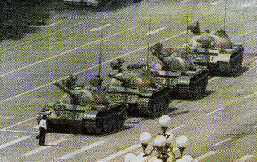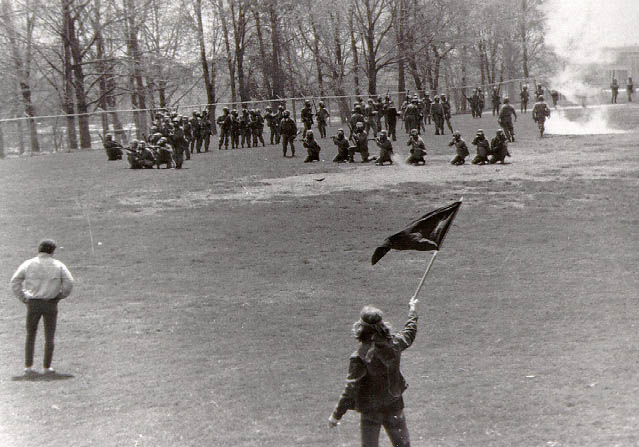|
Nonviolence, a method used by many to achieve
their goals without the use of force upon an opposing party. Nonviolence has long been used as an effective way of
obtaining power for the minority, but there are certain times where
it has erupted into an ugly and terrible scene.
Certainly one may claim that had the protestors been violent
from the start that tragedy would have ensued even earlier.
Two of the most horrific and famous nonviolent protest
incidents are the Kent State Massacre and the Tiananmen�s Square
Massacre. The problem
with nonviolence is that when it comes down to it the protestors
have no way to defend themselves, but they are so persistent that
force is sometimes the only way to alleviate the situation.
The issue at hand though is that the above-mentioned
incidents were a case where the use of force was both brutal and
extraneous.
Tiananmen�s
Square
On April 15, 1989 Hu Yaobang, a Communist
leader, died in China causing an uproar among the student community. These rallies continued for months and involved millions of
people. The largest and
most famous rally was held at Tiananmen�s Square in Beijing where
over one million people gathered in an attempt to instill more
democratic ideas in the heads of the Communist policymakers.
The students were using nonviolent methods and simply
gathering at the square and preventing the PLA (People�s
Liberation Army) from entering. Supposedly fearing that it would
soon turn hostile the Chinese government ordered the use of all
force necessary to clear out the protestors.
June 4th was the day where the tension and
hostility finally culminated and caused the deaths of thousands of
civilians. At first the
PLA simply fired tear gas into the crowd, but later the army turned
to machine guns and tanks to clear them out.
Below is one of the most famous pictures of the incident.
It is a man standing in front of a line of tanks in an
attempt to stop them.
To
look at an entire pictorial
documentary including the PLA�s brutality go to http://www.christusrex.org/www1/sdc/tiananmen.html. Although this horrible tragedy ended the lives of
many innocent students it strengthened their point on how terrible
the Chinese government was. It was a perfect example of
political jiu-jitsu and the paradox of repression. The Chinese
government helped prove the students� points for them about how
terrible it was and how there was truly such a need for
reform.
Tiananmen�s Square protestors set out to show
their lack of consent toward the government.
Governments need the consent of the people that they are
ruling, and the protestors were attempting to show their lack of
consent in order to change policies.
They weren�t really trying to do anything else, but the
chain of events that ensued did more than they expected.
The peaceful protestors were upset because they were being
ruled by a very militaristic communist government and want change,
but the government broke up the protest and brutally murdered the
protestors by using the very type of force that they were protesting
against. This is a
perfect unintentional example of political jiu-jitsu.
For force that the government possessed was used to stop the
peaceful protest and it showcased to the public of the world that
the protestors were right and there needed to be reforms.
Unfortunately many people lost their lives, but it truly shed
light on the gripes and proved them correct.
Kent
State Massacre
�Peace cannot be attained through violence�
a quote from the Daily Forty Niner staff editorial at Kent State
University after 4 students were killed and 9 more were injured
after the National Guard opened fire on the protestors.
It was 1970 and the Vietnam War was in full swing.
People across the country were protesting the bombing in
Cambodia. One specific campus that was particularly active was that of
Kent State University in Ohio.
The students were protesting in front of one of the dorms and
became violent. That
was the turning point in the ordeal.
Had the students stayed non-violent they probably would have
gotten their point across and walked out, something that didn�t
happen. According to an
article found at http://www.acs.csulb.edu/~d49er/Issue29/29okent.html
and a chronology of all the events leading up to, during, and after
the massacre at http://members.aol.com/nrbooks/chronol.htm.
the national guard was sent in after the students burned the
ROTC building down. The
students had become rowdy and Ohio governor James A. Rhodes was
quoted as saying he promises to use �every force necessary� to
maintain order. The
night of the massacre the students were protesting in front of a
University dorm and began throwing rocks at the National Guard
officers. One report
claims that a student fired a pistol out of a window (this has been
disputed) and with that the guards began to open fire on the crowd.
Four students were killed and nine were left injured.
This incident did not invoke as much sympathy as
Tiananmen�s Square for a couple of reasons.
The students were in the wrong and used force so the
guardsmen didn�t look as bad.
Also they failed to bring an organized third party majority
over to their side.
Both these incidents
were tragedies that could have been avoided.
One was a true example of non-violence turned terribly wrong
while the other was a borderline non-violence issue where the anti
war protestors used some violence and lost some of their credibility
and in four cases their lives.
They didn�t follow traditional guidelines for non-violent
protesting and bad things occurred whereas in China the protestors
were not in the wrong, but were merely victims of the terrible
violent Communist government that they were protesting against.
This terrible incident
doesn�t necessarily exhibit a theory of nonviolence.
It shows how nonviolence may be a better option than violence
against the state. The
protestors were able to stay and make their point for extended
periods of time while remaining nonviolent.
Many people saw what they were talking about and it helped
their cause, but whe they became violent everything fell apart.
Their protest was broken up, people were injured and killed,
and their point of view lost respect.
They were supposedly nonviolent protestors protesting against
the war used violence against National Guardsmen and burned down a
campus building. These
people fell away from the principles that their entire argument was
set up to defend and they fell apart. |

